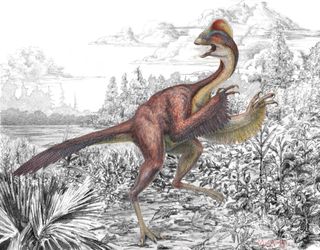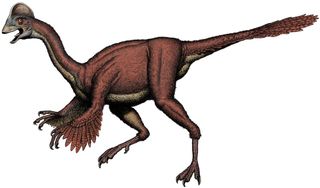Flashy New 'Chicken from Hell' Dino Discovered

A beaky, crested dinosaur nicknamed the "chicken from hell" has been discovered in both North and South Dakota.
This was not a "chicken" you'd want to stumble across in the barnyard: The new dino, dubbed Anzu wyliei, was about 11 feet (3.5 meters) long and about 10 feet (3 m) tall. It boasted a flashy head crest and probably wore feathers. Anzu wylieli lived at the same time as Tyrannosaurus rex, but was more lithe and graceful, said study researcher Emma Schachner.
"It's a fairly delicate animal compared to the large predators that were living at the time," Schachner, a postdoctoral researcher at the University of Utah, told Live Science. [Avian Ancestors: Dinosaurs That Learned to Fly]
Finding a new species
Anzu wylieli's story starts about a decade ago with paleontologist Tyler Lyson, now at the Smithsonian's National Museum of Natural History. Lyson and his team were digging in western North Dakota near the Montana border when they discovered six bones of an unknown species. Schachner worked with Lyson to analyze and classify the bones, and the pair presented the findings as a new species at a paleontology conference soon after.

At the conference, Matthew Lamanna, a vertebrate paleontologist at the Carnegie Museum of Natural History in Pittsburgh, came over with surprising news: Those six bones were not the only example of this new species out there. A private collector had found two nearly complete skeletons of the same animal in South Dakota, and the Carnegie Museum had just acquired those fossils.
"Matt came over and said, 'Oh my gosh, this is the same specimen that Carnegie spent a lot of money to buy,'" Schachner said.
Sign up for the Live Science daily newsletter now
Get the world’s most fascinating discoveries delivered straight to your inbox.
The researchers agreed that it made no sense to name the species based on six bones when two nearly complete skeletons were awaiting analysis. They worked together over the next decade, also meeting up with the Smithsonian's Hans-Dieter Sues.
Naming the hell chicken
That work has finally come to fruition, with the researchers publishing their findings today (March 19) in the journal PLOS ONE. It is the first time Schachner has been involved in the naming of a dinosaur.
"That's one thing, when you're a little kid, you kind of always dream of doing," she said.
The creature has two namesakes. The first, Anzu, translates to mean "Mesopotamian feathered demon." The new fossils were not found with feathers, Schachner said, but the dinosaur's close relatives had them, and it's highly likely Anzu wylieli did, too.
The second part of the name, wylieli, refers to a boy named Wylie, the grandson of a major donor to the Carnegie Museum. The researchers did kick around some joke names before settling on Anzu wylieli, however. A favorite, Schachner said, was Phobo gallus, which roughly translates to "fear chicken."
The Anzu bones were found in an environment that was once a swampy floodplain. The dinosaur lived during the Late Cretaceous, between about 100 million and 66 million years ago. It was likely omnivorous, eating plants, eggs and perhaps small animals. One of the specimens was found with debris of shells and tiny vertebrae between its ribs and pelvis, but the scientists aren't sure whether these fossils represent gut contents or whether they simply washed up next to the dinosaur bones.
The bones do, however, show evidence of the dinosaurs' rough-and-tumble existence. The North Dakota specimen has what looks like a broken and slightly healed rib. One of the South Dakota specimens shows bony healing suggesting trauma to the toe.
Anzu wyliei is part of a group called oviraptorosaurs, which are closely related to birds. The dinosaur is also part of an oviraptorosaur subgroup called the caenagnathids, which are an "enigmatic group of dinosaurs," Schachner said.
"They're not really well-known," she said. "This is a strong addition to the group where you have the anatomy clearly detailed."
Follow Stephanie Pappas on Twitter and Google+. Follow us @livescience, Facebook & Google+. Original article on Live Science.

Stephanie Pappas is a contributing writer for Live Science, covering topics ranging from geoscience to archaeology to the human brain and behavior. She was previously a senior writer for Live Science but is now a freelancer based in Denver, Colorado, and regularly contributes to Scientific American and The Monitor, the monthly magazine of the American Psychological Association. Stephanie received a bachelor's degree in psychology from the University of South Carolina and a graduate certificate in science communication from the University of California, Santa Cruz.